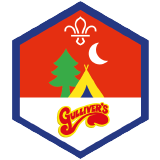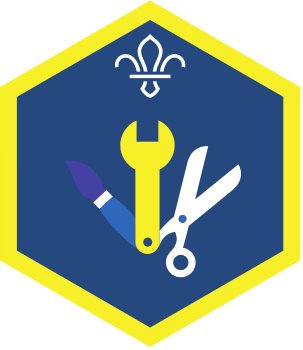
Make a mini canoe
You’ll need
- Copies of the instruction sheet (1 per pair)
- Long flexible sticks, such as willow sticks (3 per pair)
- Lots of smaller twigs and sticks (per pair)
- Lots of leaves (per pair)
- String (per pair)
- Scissors (1 per pair)
- Knife (1 per pair)
- Ruler (1 per pair)
- Pencil sharpener (1 per pair)
- Access to water
- A paddling pool, large bucket or washing up bowl
- Towels
Before you begin
- Use the safety checklist to help you plan and risk assess your activity. Additional help to carry out your risk assessment, including examples can be found here. Don’t forget to make sure all young people and adults involved in the activity know how to take part safely.
- Make sure you’ll have enough adult helpers. You may need some parents and carers to help if you’re short on helpers.
Setting up this activity
- Make sure you collect plenty of twigs and leaves for everyone to make a mini canoe. You could also ask young people to bring some in, or you may want to collect the items on a separate session before running this activity.
- Before you start, explain the safety rules around using a knife. Never walk around with knife. Always hold it blade side down. Take care when cutting to make sure fingers are away from the blade. Take a look at our knife safety guidance.
- Fill a bucket, paddling pool or washing up bowl with water and put it to one side. You may want to move it or use it outside. You can test the canoes on the water. Have some towels close by to help clean up any spills.
- Gather everyone together and ask if anyone knows what a canoe is. What does a canoe look like? Has anyone ever been in a canoe before? What was it like?
- Tell everyone that today they’ll be making their own canoe out of natural materials.
Run the activity
- You could show everyone a pre-made canoe model, but emphasise that this is just one example and that their model might be very different.
- Ask everyone to get into pairs and give out the equipment to each pair.
- Tell everyone to take the three longest, most flexible sticks. Gently bend them until they hold a curved shape. There should be two curved sticks to form the sides and one curved stick to make the bottom of the boat.
- One person should hold them in place, while another person takes some string and binds all three sticks together at each end. They should wrap the string around several times and tie a knot to secure them.
- Using scissors or knife, cut a stick that’s approximately 8cm long. Carefully use a pencil sharpener to sharpen both ends of the stick until it’s a point.
- When you’re ready, bend the stick gently until it holds a curve. Place the stick widthways in the middle of your canoe. The pointed ends can be pushed into the thicker stick frame, which should stop it slipping while you bind it in place. This forms a rib.
- Add two more twig ribs widthways to the canoe, placing them widthways between the end of the canoe and the middle rib. Again, if the sticks are cut to the right length, they can be held under tension in the frame without requiring binding. However, you may want to bind them.
- Next, place two more sticks lengthways to help strengthen the boat. You may want to bind them to the main structure.
- When you’re ready, add several more flexible and bendier sticks across the canoe's width. You can weave these into place, weaving them in between the lengthways sticks, to help form a strong structure.
- The shell of the canoe is made by bending and weaving leaves into the canoe. Once you’ve added the leaves, you can weave in some extra twig ribs to keep the leaves in place. You want to sandwich the leaves between the two sets of twigs.
- Now you can test your canoe. Carefully place it in water and see if it floats. If it doesn’t, you may need to modify it.
- Use the towels to dry the canoe off after it’s been in the water to help keep the floor dry and safe.
- You could make your canoe move by adding a partially inflated balloon and then releasing the air.
Reflection
This activity was all about making a canoe out of natural materials. What did you enjoy most about this activity?
You had to work as a team to make the canoe. How did you work well together? How did you make sure everyone had a go? Did you help each other, or ask each other for support when you didn’t understand something or struggled with something? Did you teach each other how to do any parts of the build? How did you communicate, and did you make sure to be patient?
You also had to problem-solve, especially if something went wrong or the canoe didn’t float. What challenges or problems did you face? How did you fix them? Did your canoe float? What did you do if the canoe didn’t float?
Safety
All activities must be safely managed. You must complete a thorough risk assessment and take appropriate steps to reduce risk. Use the safety checklist to help you plan and risk assess your activity. Always get approval for the activity, and have suitable supervision and an InTouch process.
- Sharp objects
Teach young people how to use sharp objects safely. Supervise them appropriately throughout. Store all sharp objects securely, out of the reach of young people.
- Scissors
Supervise young people appropriately when they’re using scissors. Store all sharp objects securely, out of the reach of young people.
- Water games and activities
Be careful when doing activities with, in, or near water. Check surfaces and reduce the risk of slipping where possible. Make sure you have appropriate supervision for this activity.
- To make this activity easier, provide a printed instruction sheet for pupils to follow, or you could explain each step. To make this activity harder, why not let them explore the materials and come up with their own methodology? You could give ideas on construction techniques, such as weaving the green sticks together or binding with twigs.
- To make this activity easier, you could have an adult or young leader working with each pair. You could also make the teams into small groups, rather than pairs, so people can help each other.
- To make this activity easier, you could have the canoe shape already made from the three sticks, so people just need to add twigs and leaves.
- To make this activity harder, you could have a competition to see how much weight each canoe can hold before it sinks. You could use coins, plastic building blocks, crayons or other small items that won’t get damaged by water. You could also try making the canoe from different material and see which works best in keeping the canoe afloat.
- Some people may find bending the sticks or binding the string a bit fiddly. They could work with a friend, adult or young leader who could help them.
- Some people might not be able to bend and twist the sticks. Could they take on another role, such as putting the canoes on the water to test them or helping add leaves?
All Scout activities should be inclusive and accessible.
- You can add a partially inflated balloon to one end of the canoe and release the air and watch the canoe move.
- You could find another safe, still body of water and race the canoes or seeing how far each one travels. Take a look at our water safety guidance and guidance for activities near water.

